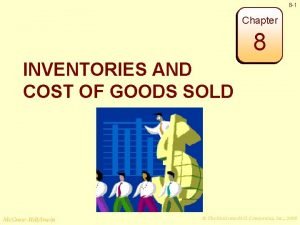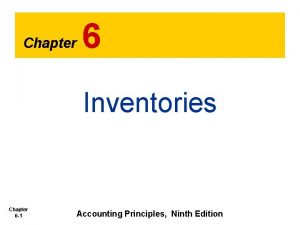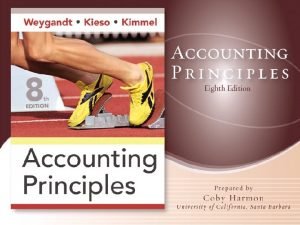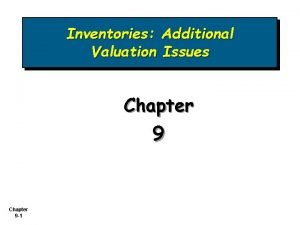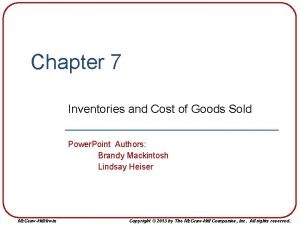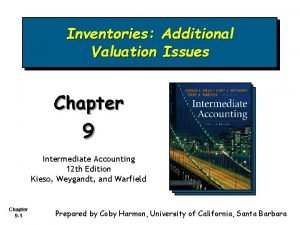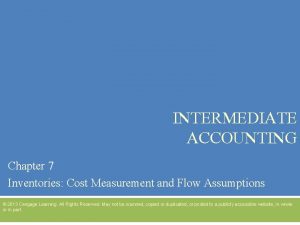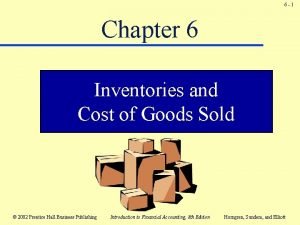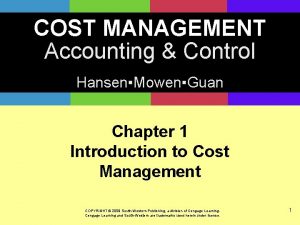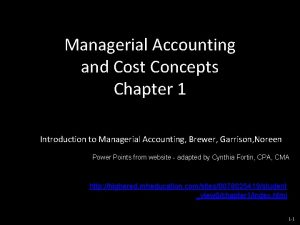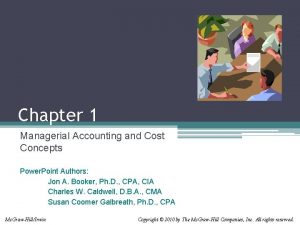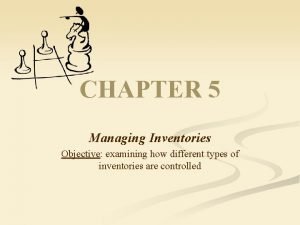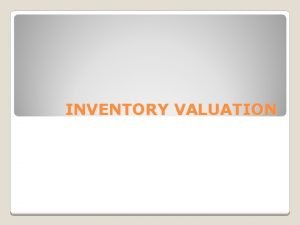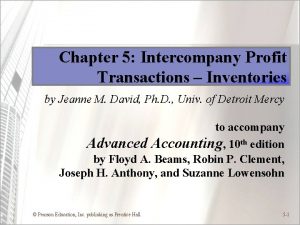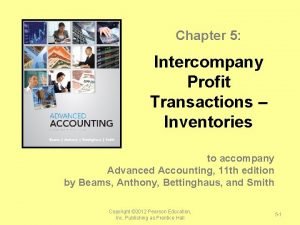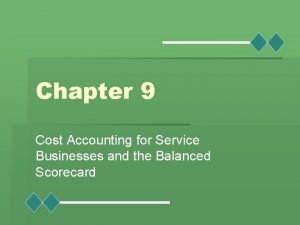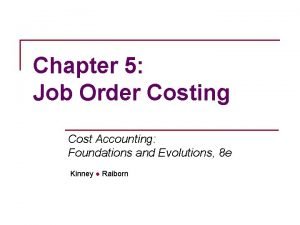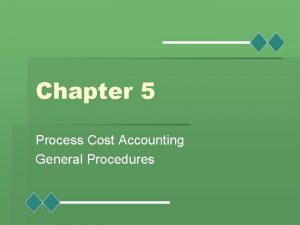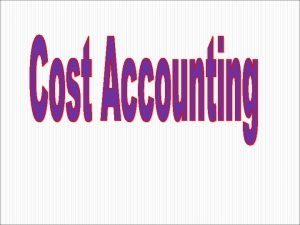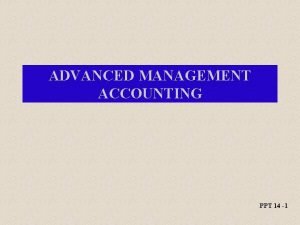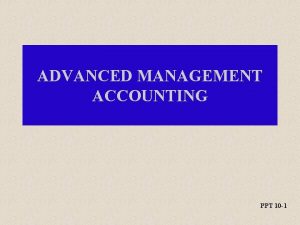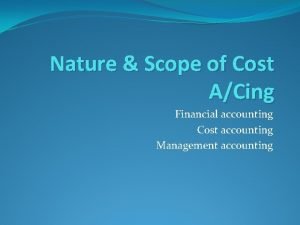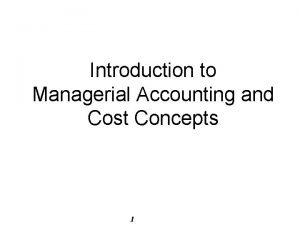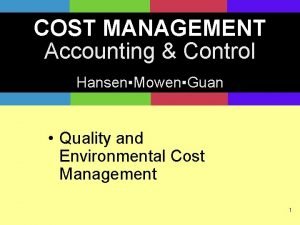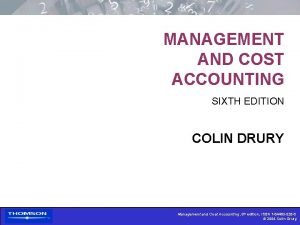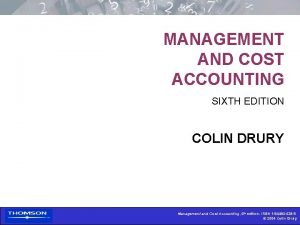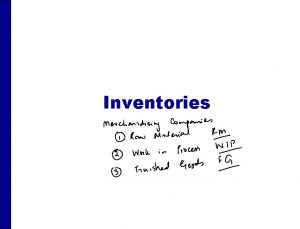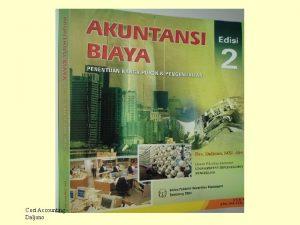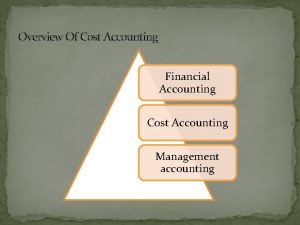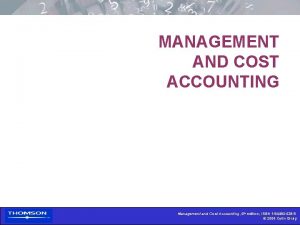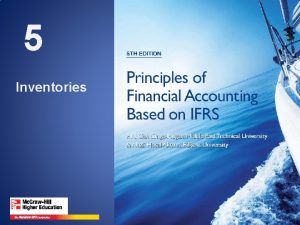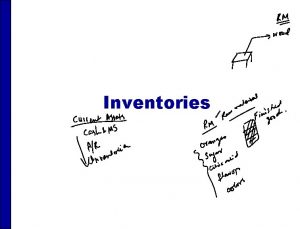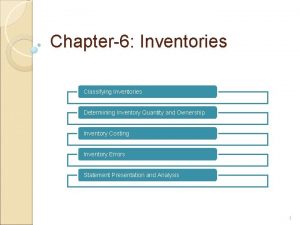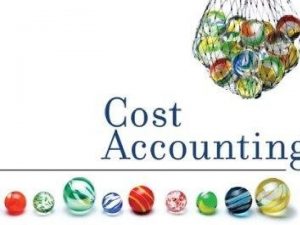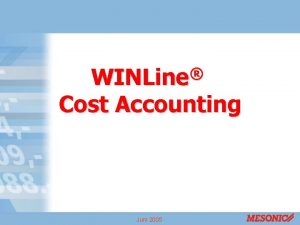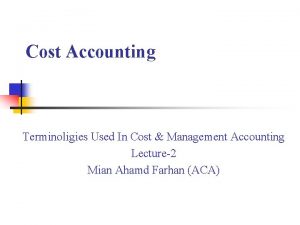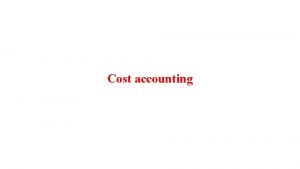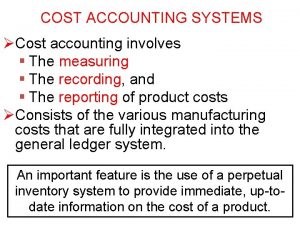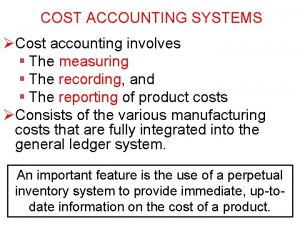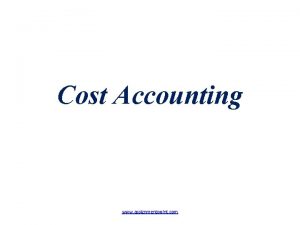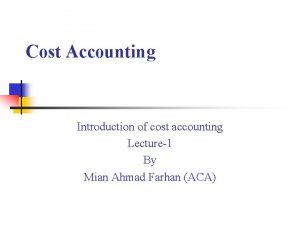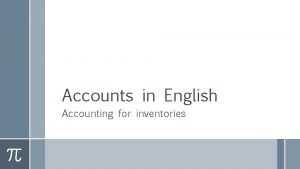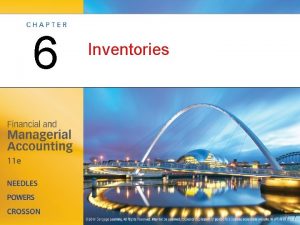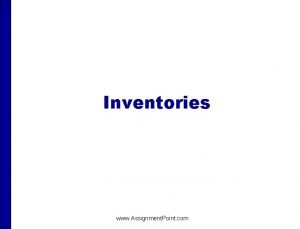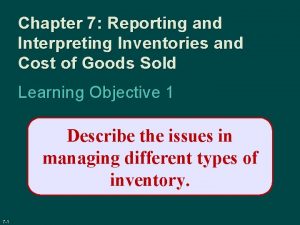Chapter 45 Accounting for Inventories and Cost of















































- Slides: 47

Chapter 4&5 Accounting for Inventories and Cost of Goods Sold Mugan-Akman 2007

Current Assets-Inventories Service Chapter 4&5 Merchandising Wholesale Retails Manufacturing Merchandise Raw Material Work-in Process Finished Goods Mugan-Akman 2007

How do we determine the Acquisition Cost of Purchased Inventory? –Determine purchase price : • ordering goods + • receiving + • inspecting + • Recorded when title passes to the firm. –Adjust purchase price for: –transportation ( add) –handling (add) –customs and duties (add) –cash discounts (deduction) –returns (deduction) –to determine the acquisition cost Cost of inventory should include all costs incurred to acquire goods and prepare them for sale. Chapter 4&5 Mugan-Akman 2007

How do we record the transactions? Depends on the recording system: Perpetual or Periodic Perpetual Inventory System: • A running record of purchases are kept through “merchandise inventory” account • Purchases entries and Adjustments are made to the merchandise inventory account • The amount of inventories at a point in time can be determined • Cost of Goods sold is known during the period Chapter 4&5 Periodic Inventory System: • Purchases of inventory are recorded in “Purchases” account • Adjustments are made to separate accounts“ • Amount of inventories at a point can not be determined unless a physical count is made • Cost of goods sold can be determined after physical count at the end of the period Mugan-Akman 2007

How do we determine the cost of goods that are sold -COGS? Perpetual • Accumulated in cost of goods sold account as sales are made • Known during the period • Physical count made at the end – helps to determine inventory shrinkage Chapter 4&5 Periodic • Cost of goods sold can be determined after the physical count • Beginning Inventory (from previous period) + • Purchases (net) – • Ending Inventory (physical count) = • Cost of goods sold • Cannot determine inventory shrinkage Mugan-Akman 2007

Chapter 4&5 Mugan-Akman 2007

Accounting for Sale of Merchandise- Perpetual Inventory System TWO ENTRIES ARE NECESSARY TO RECORD A SALE UNDER PERPETUAL INVENTORY SYSTEM 1. To record the sale transaction 2. To reflect the cost of the sales (cost of goods sold) made and deduct the cost of sales from the inventory 1) Record sale 2) show the decrease in inventory and the corresponding increase in COGS Chapter 4&5 Mugan-Akman 2007

Gross Profit GROSS PROFIT = NET SALES – COST OF GOODS SOLD= BEG INV + PURCHASES –END INV GROSS PROFIT PERCENTAGE= GROSS PROFIT/NET SALES Chapter 4&5 Mugan-Akman 2007

COGS Computation Chapter 4&5 Mugan-Akman 2007

Single Step Income Statement • Deduct all expenses from the total of revenues without a distinction among the different sources of revenues or the causes of expenses Chapter 4&5 Mugan-Akman 2007

Giysi Giyim A. S. Income Statement For the Year Ended 31 December 2004 Chapter 4&5 Mugan-Akman 2007

Multiple Step Income Statement • Discloses numerous parts or steps to determine net income, showing income from operating and non-operating activities Chapter 4&5 Mugan-Akman 2007

Giysi Giyim A. Ş. Income Statement For the Year Ended 31 December 2007 Chapter 4&5 Mugan-Akman 2007

Composition of Inventories INVENTORY = Unit cost * Quantity • taking a physical count of inventories • determining the ownership of goods. Unit Cost • Cost Flow Assumptions Chapter 4&5 Mugan-Akman 2007

Taking Physical Count During the physical count, a company should pay very close attention to the following issues in order to have an effective internal control and also to minimize the errors and fraud: 1. the employees who are responsible from safekeeping of inventory items should not count them, 2. it has to be made sure that the items are complete and what they are supposed to be, 3. items should be re-counted by another independent employee for verification, 4. counting process should be documented by tagging the inventory items, 5. a supervisor should oversee that each item has only one tag, and that each item is counted, and 6. there should be no inventory movements during the count Chapter 4&5 Mugan-Akman 2007

Whose ? Determination of the owner of goods: • Consignment goods – consignor (owner of the merchandise) and the consignee (the holder of the goods) • Goods in transit are goods that are on the way to the company (purchases) or goods that are on a carrier being shipped to the customer Chapter 4&5 Mugan-Akman 2007

Seller F. O. B. SHIPPING POINT WHO OWNS THE GOODS ON THE WAY? Buyer Chapter 4&5 Mugan-Akman 2007

Seller F. O. B. DESTINATION WHO OWNS THE GOODS ON THE WAY? Buyer Chapter 4&5 Mugan-Akman 2007

Inventory Costs Beginning Inventory + Purchases - Ending Inventory = COGS Available for Sale Chapter 4&5 Mugan-Akman 2007

Inventory Cost Flows • • Specific Identification Method First-in First-out Weighted Average Last-in First-out – not allowed by IFRS or CMB Chapter 4&5 Mugan-Akman 2007

Specific Identification Method • used when the actual cost of the item is tracked • closely follows the actual flow of goods • whether a company uses a periodic or perpetual inventory system does not make any difference on cost of goods sold or the amount of inventory Chapter 4&5 Mugan-Akman 2007

Cost Flow vs. Physical Flow • First-in First-out (FIFO), and weighted average methods assume that flow of costs may be unrelated to physical flow of goods • The accounting regulations do not require that the physical flow of goods and the related cost flow to be the same Chapter 4&5 Mugan-Akman 2007

Example-Cost Flow Chapter 4&5 Mugan-Akman 2007

First-in First-out Method FIFO • FIFO method assumes that the goods purchased earlier will be sold first • The cost of the first units on hand is assigned to the units sold first Chapter 4&5 Mugan-Akman 2007

Chapter 4&5 Mugan-Akman 2007

Weighted Average • Goods available are homogeneous and the cost to be assigned to each unit sold is the same Chapter 4&5 Mugan-Akman 2007

Weighted Average-Perpetual Chapter 4&5 Mugan-Akman 2007

Summary Perpetual Inventory System Chapter 4&5 Mugan-Akman 2007

Lower of Cost or Net Realizable Value • as time passes the value of the inventories might decline in the market because of the obsolescence factor • IFRS specify that the companies should use the lower-of -cost-or net realizable (LCNRV) valuation basis • Net realizable value is the expected sales price less costs to sell • LCNRV rule can be applied with any of the cost flow methods, or the specific identification method • LCNRV may be applied to individual items or major categories of inventory • the decline in value is not expected to increase in the very near future Chapter 4&5 Mugan-Akman 2007

Example-LCM-1 Item by item Chapter 4&5 Mugan-Akman 2007

Example-LCM-1 Item by item Chapter 4&5 Mugan-Akman 2007

Example-LCM-2 on 15 August 2008, the company sold 15 units of Item W at TL 126 per unit Chapter 4&5 Mugan-Akman 2007

Example-LCM-3 Using item-by-item basis 31 December 2008 Chapter 4&5 Mugan-Akman 2007

39% o f curren ta ssets Chapter 4&5 Mugan-Akman 2007

Allowance for decline in value of inventory Chapter 4&5 Mugan-Akman 2007

Inventory Errors Chapter 4&5 Mugan-Akman 2007

Inventory Errors Chapter 4&5 Mugan-Akman 2007

Inventory Management and Ethical Issues • inventories are closely related with net income and thus with the shareholders’ equity, and the assets • taking decisions that would affect the ending inventory and cost of goods sold amount, the management can manipulate income • for example, management might decide to make a large purchase at the end of the period, in order to maximize profits in that period, and then return the goods at the beginning of the following period stating that they are not according to specifications Chapter 4&5 Mugan-Akman 2007

Manufacturing Operations CLASSES OF INVENTORIES Chapter 4&5 MANUFACTURING COSTS Raw Materials Direct Materials Work-in-process Direct Labor Finished Goods Mfg. Overhead Mugan-Akman 2007

Chapter 4&5 Mugan-Akman 2007

Chapter 4&5 Mugan-Akman 2007

Chapter 4&5 Mugan-Akman 2007

Accrued salaries and wages of direct labor Chapter 4&5 Mugan-Akman 2007

Chapter 4&5 Mugan-Akman 2007

Chapter 4&5 Mugan-Akman 2007

Analysis of Inventories • To check whether adequate profits are generated by the operations • To check whether inventory is adequate or more than adequate to meet future demands Chapter 4&5 Mugan-Akman 2007

Some Ratios very low ratio might point to some problems that are related to pricing policies, and inefficiencies in the production process a high turnover ratio usually shows that a company does not have obsolete products that it cannot sell Average Number of Days' Inventory on Hand = 365 days / Inventory Turnover Ratio shows whether a company has adequate stock on hand; can be used as an indicator of holding obsolete inventory Chapter 4&5 Mugan-Akman 2007
 Chapter 8 inventories and the cost of goods sold
Chapter 8 inventories and the cost of goods sold Principles of accounting chapter 6 answers
Principles of accounting chapter 6 answers Inventory in the balance sheet
Inventory in the balance sheet Chapter 9 inventories additional valuation issues
Chapter 9 inventories additional valuation issues Chapter 7 inventories
Chapter 7 inventories Lower of cost or market
Lower of cost or market Inventory intermediate accounting
Inventory intermediate accounting Chapter 6 inventories
Chapter 6 inventories Cost management accounting and control
Cost management accounting and control Chapter 1 managerial accounting and cost concepts
Chapter 1 managerial accounting and cost concepts Chapter 1 managerial accounting and cost concepts
Chapter 1 managerial accounting and cost concepts Intermediate accounting chapter 1
Intermediate accounting chapter 1 Strengths and weaknesses assessment
Strengths and weaknesses assessment Non recycled inventories in housekeeping
Non recycled inventories in housekeeping Mnemjian inventories
Mnemjian inventories Juloidian inventories
Juloidian inventories Golf techniques of inventory control
Golf techniques of inventory control Intercompany profit transactions inventories
Intercompany profit transactions inventories Intercompany inventory transactions
Intercompany inventory transactions Smarter inventories
Smarter inventories Cost accounting chapter 9
Cost accounting chapter 9 Chapter 5 job order costing solutions
Chapter 5 job order costing solutions Examples of process costing
Examples of process costing Cost accounting chapter 5
Cost accounting chapter 5 Cost accumulation and cost assignment
Cost accumulation and cost assignment Cost accumulation and cost assignment
Cost accumulation and cost assignment Cost accumulation and cost assignment
Cost accumulation and cost assignment What is a period cost on the income statement
What is a period cost on the income statement Cost control and cost reduction difference
Cost control and cost reduction difference Meaning of standard costing in cost accounting
Meaning of standard costing in cost accounting Distinguish between average cost and marginal cost
Distinguish between average cost and marginal cost Cost control and cost reduction difference
Cost control and cost reduction difference The flow of costs in job order costing
The flow of costs in job order costing Ordering cost and carrying cost
Ordering cost and carrying cost Trade off and opportunity cost
Trade off and opportunity cost Cost control and cost reduction project report
Cost control and cost reduction project report Cost control and cost reduction project report
Cost control and cost reduction project report Cost structure refers to the relative proportion of
Cost structure refers to the relative proportion of Cost accounting definition
Cost accounting definition Introduction to cost accounting ppt
Introduction to cost accounting ppt Advanced cost and management accounting ppt
Advanced cost and management accounting ppt Nature and scope of cost accounting
Nature and scope of cost accounting Managerial accounting basics
Managerial accounting basics Cost management accounting and control
Cost management accounting and control Advanced corporate accounting ppt
Advanced corporate accounting ppt Drury management and cost accounting
Drury management and cost accounting Drury c management and cost accounting
Drury c management and cost accounting Full cost method of accounting oil and gas
Full cost method of accounting oil and gas
